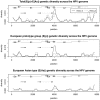Whole genome sequencing and evolutionary analysis of human papillomavirus type 16 in central China
- PMID: 22574185
- PMCID: PMC3344914
- DOI: 10.1371/journal.pone.0036577
Whole genome sequencing and evolutionary analysis of human papillomavirus type 16 in central China
Abstract
Human papillomavirus type 16 plays a critical role in the neoplastic transformation of cervical cancers. Molecular variants of HPV16 existing in different ethnic groups have shown substantial phenotypic differences in pathogenicity, immunogenicity and tumorigenicity. In this study, we sequenced the entire HPV16 genome of 76 isolates originated from Anyang, central China. Phylogenetic analysis of these sequences identified two major variants of HPV16 in the Anyang area, namely the European prototype (E(p)) and the European Asian type (E(As)). These two variants show a high degree of divergence between groups, and the E(p) comprised higher genetic diversity than the E(As). Analysis with two measurements of genetic diversity indicated that viral population size was relatively stable in this area in the past. Codon based likelihood models revealed strong statistical support for adaptive evolution acting on the E6 gene. Bayesian analysis identified several important amino acid positions that may be driving adaptive selection in the HPV 16 population, including R10G, D25E, L83V, and E113D in the E6 gene. We hypothesize that the positive selection at these codons might be a contributing factor responsible for the phenotypic differences in carcinogenesis and immunogenicity among cervical cancers in China based on the potential roles of these molecular variants reported in other studies.
Conflict of interest statement
Figures


References
-
- Parkin DM. The global health burden of infection-associated cancers in the year 2002. Int J Cancer. 2006;118:3030–3044. - PubMed
-
- Munoz N, Bosch FX, de Sanjose S, Herrero R, Castellsague X, et al. Epidemiologic classification of human papillomavirus types associated with cervical cancer. N Engl J Med. 2003;348:518–527. - PubMed
-
- Cogliano V, Baan R, Straif K, Grosse Y, Secretan B, et al. Carcinogenicity of human papillomaviruses. Lancet Oncol. 2005;6:204. - PubMed
Publication types
MeSH terms
Substances
LinkOut - more resources
Full Text Sources
Other Literature Sources
Research Materials
Miscellaneous

